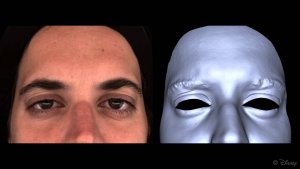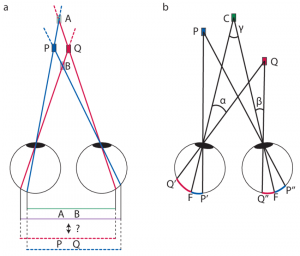In our previous article we outlined the basis of most applications within computer vision. It is a vast and large field. It has a lot of intersectionality with 3D technology and the future of 3D printing as well as metrology. The field of 3D imaging in general takes a wide skill set in general and that is exciting. In this article we will talk about a specific realm within 3D metrology and machine vision and computer vision. This realm is known as 3D reconstruction.
3D reconstruction is the process of capturing the shape and appearance of real objects. This process can be accomplished either by active or passive methods. If the model is allowed to change its shape in time, this can be referred to as non-rigid or spatio-temporal reconstruction. Spatio-temporal reconstruction refers to 4D reconstruction as it is adding the 4th element of time into creating an object (x-position, y-position, z-position, and time).
 Spatio-temporal reconstruction of eyelids
Spatio-temporal reconstruction of eyelids
2D digital image acquisition is the typical information source of 3D reconstruction. 3D reconstruction is based on multiple images, and it may use only one image in some cases. There are various methods for image acquisition that depend on the occasions and purposes of an application. Visual disparity, illumination, performance of the camera, and the scenario should be considered when attempting to do a 3D reconstruction.
In terms of metrology, the objects used to measure the 3 dimensional object as a whole include a camera as well as a data interpreter such as a computer. The camera will take 2D images in terms of digital image data. This is referred to as a monocular cue method for data collection. Monocular cues typically include a singular viewport, such as a camera with one lense. Monocular cues methods refer to using one or more images from one viewpoint to create a 3D construction. It makes use of 2D characteristics (e.g. Silhouettes, shading and texture) to measure 3D shape, and that’s why it is also named Shape-From-X, where X can be silhouettes, shading, texture, etc. 3D reconstruction through monocular cues is simple and quick, and usually one digital image so it requires only one camera. Stereo correspondence is a fairly complex problem that this method tries to avoid.
Stereo correspondence refers to correspondence problem of 3D reconstruction. The correspondence problem refers to the problem of realizing which parts of an image correspond to certain parts of a different image. Differences are due to movement of a camera, time changing, and/or movement of objects in a photo.
When we have two or more images of the same 3D scene, taken from different points of view, the correspondence problem refers to how we find a set of points in one image that are classified as the same points in another image. Points or features in one image are matched with the matching points or features in another image. The images can be taken from a different point of view, at different times, or with objects in the scene in general motion relative to a camera(s).
This problem of stereo correspondence is most prevalent when multiple devices are used to capture images. If two photographers take an image of a scene, it is nearly impossible to have them sync up their 3D data from the 2D forms that they took. One frame of reference may include an extreme amount of information that does not sync with a frame of reference that may be only a couple meters away.
A typical application of the correspondence problem is found in panorama creation or image stitching. When two or more images that have a small overlap are stitched into a larger image this problem is apparent. It is necessary to be able to identify a set of corresponding points in a pair of images in order to calculate the transformation of one image to stitch it onto the other image.
In our next article we will be analyzing a particular method within measurement that deals with this problem and the advanced physics behind it.
Subscribe to Our Email Newsletter
Stay up-to-date on all the latest news from the 3D printing industry and receive information and offers from third party vendors.
You May Also Like
New Report: Semiconductor Industry to See $1.4B in 3D Printing Revenues by 2032
“The semiconductor sector has become the most strategically significant area of global industry.” Truer words are hard to come by when it comes to the modern world, and they are...
Will Photonic-Crystal Lasers Revolutionize 3D Printing?
Powder bed fusion (PBF) for metals and polymers predominantly utilizes lasers as the primary heat source. Some directed energy deposition (DED) technologies also employ lasers, while various vat polymerization methods...
3D Printing Unpeeled: Orbex Investment, IndoMIM and HP, Ultrasonic Waves
INDO-MIM has bought three HP Metal Jet S100 printers, operating two in India and one in Texas. This is a win for HP because the company has deep experience in...
3D Printing Webinar and Event Roundup: April 21, 2024
It’s another busy week of webinars and events, starting with Hannover Messe in Germany and continuing with Metalcasting Congress, Chinaplas, TechBlick’s Innovation Festival, and more. Stratasys continues its advanced training...

































